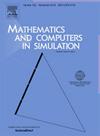心脏和神经信号传播时空模拟的时间图方法
IF 4.4
2区 数学
Q1 COMPUTER SCIENCE, INTERDISCIPLINARY APPLICATIONS
引用次数: 0
摘要
我们提出了一种新的计算方案,利用时间图,一个标量场表示的激励到达时间,以空间化时间依赖的动态心脏和神经信号传播在多维空间。时间图可以从连续动作电位成像数据、eikonal方程或控制生物信号传播的反应扩散方程的数值解中导出。一旦计算出来,时间图就可以存储和修改,以反映几何形状和域电导率的变化。时间映射可以作为常微分方程系统中的瞬时脉冲,用于快速多维传播模拟。此外,还可以在一维和二维域上从基线时间图重构出修改后的时间图。数值实验和计算仿真验证了该方法的有效性和有效性。本文还对实际应用进行了探讨,如修改时间图的快速多维模拟和修改时间图的电导率重建。本文章由计算机程序翻译,如有差异,请以英文原文为准。
Time map method for spatiotemporal simulation of cardiac and neural signal propagation
We propose a novel computational scheme that utilizes a time map, a scalar field representing excitation arrival time, to spatialize the time-dependent dynamics of cardiac and neural signal propagation in multidimensional spaces. The time map can be derived from sequential action potential imaging data, the eikonal equation, or numerical solutions of reaction–diffusion equations governing biological signal propagation. Once computed, the time map can be stored and modified to reflect changes in geometry and domain conductivity. The time map can be used for rapid multidimensional propagation simulations by serving as an instantaneous impulse in systems of ordinary differential equations. Furthermore, a modified time map can be reconstructed from the baseline time map in one- and two-dimensional domains. Numerical experiments and computational simulations are presented to demonstrate the numerical efficiency and effectiveness of the proposed scheme. Practical applications are also explored, such as fast multidimensional simulation with the modified time map and conductivity reconstruction from altered time maps.
求助全文
通过发布文献求助,成功后即可免费获取论文全文。
去求助
来源期刊

Mathematics and Computers in Simulation
数学-计算机:跨学科应用
CiteScore
8.90
自引率
4.30%
发文量
335
审稿时长
54 days
期刊介绍:
The aim of the journal is to provide an international forum for the dissemination of up-to-date information in the fields of the mathematics and computers, in particular (but not exclusively) as they apply to the dynamics of systems, their simulation and scientific computation in general. Published material ranges from short, concise research papers to more general tutorial articles.
Mathematics and Computers in Simulation, published monthly, is the official organ of IMACS, the International Association for Mathematics and Computers in Simulation (Formerly AICA). This Association, founded in 1955 and legally incorporated in 1956 is a member of FIACC (the Five International Associations Coordinating Committee), together with IFIP, IFAV, IFORS and IMEKO.
Topics covered by the journal include mathematical tools in:
•The foundations of systems modelling
•Numerical analysis and the development of algorithms for simulation
They also include considerations about computer hardware for simulation and about special software and compilers.
The journal also publishes articles concerned with specific applications of modelling and simulation in science and engineering, with relevant applied mathematics, the general philosophy of systems simulation, and their impact on disciplinary and interdisciplinary research.
The journal includes a Book Review section -- and a "News on IMACS" section that contains a Calendar of future Conferences/Events and other information about the Association.
 求助内容:
求助内容: 应助结果提醒方式:
应助结果提醒方式:


